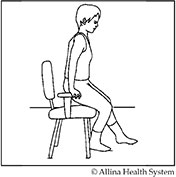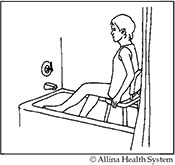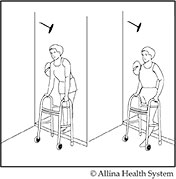
Mobility and activity techniques for daily living
After hip surgery, you may need to move differently until your hip heals. Use the following instructions to help you move throughout your day.
Getting in and out of bed

- Back up until you feel the bed against the back of your legs.
- Place your surgical leg forward.
- Reach back for the bed surface, lowering yourself slowly to the edge.
- Scoot back on the bed in a diagonal direction until your knees feel supported.
- As you turn your body to get into bed, you may need to use a leg lifter or someone to help lift your surgical leg.
- When getting out of bed, come to a sitting position on the bed.
- As you turn your body to get out of bed, you may need to use a leg lifter or someone to help move your surgical leg.
- Lean back as you push with your hands to help move your body forward until you are sitting at the edge of the bed.
- Place your surgical leg forward.
- Push up from the bed and stand up.
- Do not reach for a walking device until your balance is secure.
Do not use a walker to pull yourself up from a sitting position. This could cause you to fall.
Getting on and off a chair with arms

- To sit down, back up until you feel the chair against the back of your legs.
- Place your surgical leg forward.
- Reach back for the arms of the chair with both hands and sit down on the edge of the seat, then slide back.
- To get off the chair, slide to its edge.
- Place your surgical leg forward.
- Push up with both arms and your nonsurgical leg.
- Do not reach for a walking device until your balance is secure.
Getting on and off a toilet
- To get on and off a toilet, follow the steps above for getting on and off a chair.
- Using a raised toilet seat may make it easier and safer for you to get on and off the toilet.
- When sitting or standing, support yourself with grab bars or nearby structures (sink, counter) that are secure.
Getting in and out of the tub to take a shower

Have someone nearby the first few times you use the tub or shower to provide balance assistance if needed. It is a good idea to have hand rails or grab bars to help with your balance and support. There are two ways you can get in and out of the tub to take a shower.
Side-step transfer:
- Side-step into the tub with your nonsurgical ("good") leg first. Hold the walker, wall or grab bar for support. Next, bring your surgical ("bad") leg over the tub edge.
- Side-step out of the tub with your surgical leg first. Hold the walker, wall or grab bar for support. Next, bring your nonsurgical leg over the tub edge.
Seated transfer
- Using a shower chair with a backrest may make it easier to get in and out of the tub.
- Getting into the tub:
- Reach back for the chair, sit down, scoot back and carefully swing each leg (one at a time) over the tub edge.
- Getting out of the tub:
- Swing each leg (one at a time) over the tub edge. Scoot forward on the bench with your feet flat on the floor and push up from the shower chair to stand.
- Do not reach for a walking device until your balance is secure.
- Getting into the tub:
Getting in and out of a walk-in shower

There are two ways you can get in and out of the shower:
Back in technique:
- Approach the shower and then turn around backward to enter.
- Leave your walker outside of the shower.
- To provide balance and help you maintain your activity restrictions, it is important to have someone help you. The following items may also be helpful to keep you safe:
- a grab bar
- a shower chair
- a nonskid mat.
Side-step technique:
- Getting into the shower:
— Step into the shower with your nonsurgical leg first.
— Then step into the shower with your surgical leg.
— If a shower chair is available, reach for the seat and slowly lower yourself into a sitting position. - Getting out of the shower:
— If using a shower chair, push up from the seat and slowly stand.
— Step out of the shower with your surgical leg first.
— Then step out of the shower with your nonsurgical leg.
Reaching, bending, carrying
- Use a reliable support like the countertop or table when bending and reaching in low cupboards.
- A reacher can help reduce strain on your hip and make it easier to pick objects up from the floor.
- Do not carry or hold anything in your hands while using a walker or crutches. Use pockets in an apron, walker basket, fanny pack or backpack.
- Do not reach too far when you slide objects across a countertop.
- Try using a rolling cart to move heavy, hot or breakable items.
How to go up and down stairs
Your physical therapist will review stair climbing with you in the hospital.
- Remember to go up the step with your nonsurgical leg first, then bring your surgical leg up to the same step. "Up with the good."
- Also remember to go down the step with your surgical leg first, then bring your nonsurgical leg down to the same step. "Down with the bad."
Getting in and out of a car

A large plastic bag on the car seat may help you move more easily. Also, a firm pillow under your buttocks may be needed to increase the seat height so your hips are higher than your knees.
Anytime you are getting in or out of the car, have the driver park about four feet out from the curb edge and not on an incline. Also make sure that the surface you’ll be walking on is free of ice and snow.
Before surgery, practice getting in and out of a car using the following instructions.
- Adjust the car seat as far back as possible and recline the backrest slightly.
- Back up to your car seat. Place your surgical leg forward.
- Reach back and find a stable hand hold (dashboard, back of seat).
- Slowly lower yourself onto the seat.
- Scoot back on the car seat. Lean back as you lift each leg into the car.
- Do not reach for a walking device until your balance is secure.
Related resources